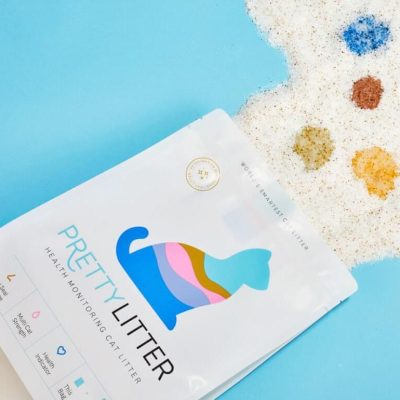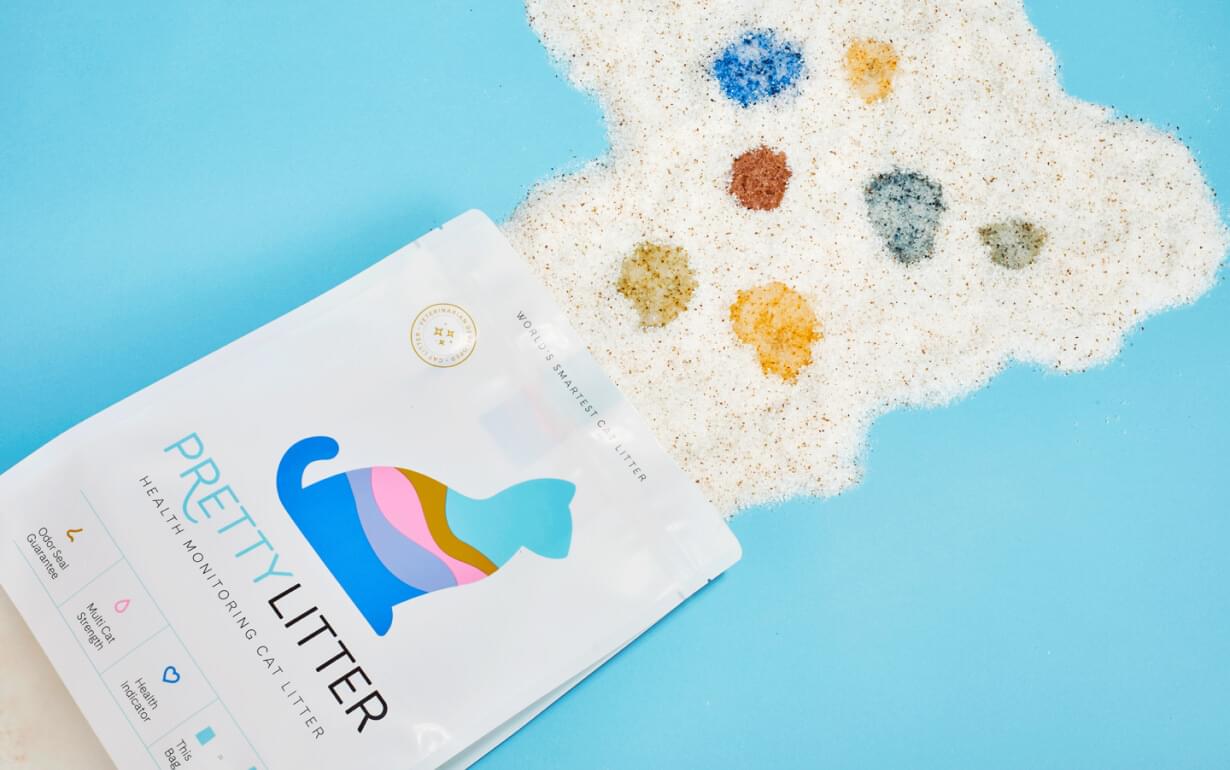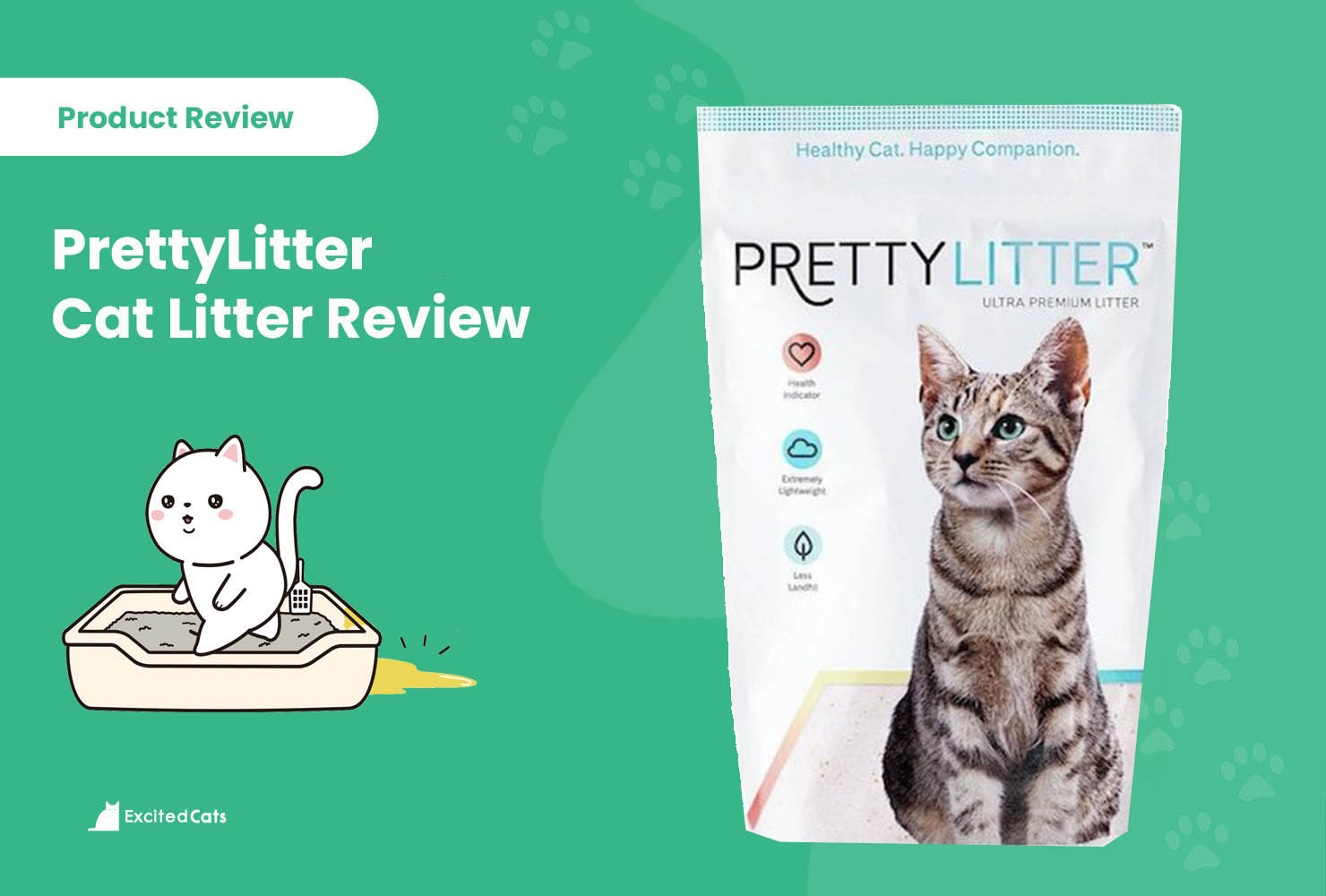Review Summary
We give this PrettyLitter a rating of 4.9 out of 5.
PrettyLitter is renowned for its ability to catch health problems early. It changes colors based on the pH of your cat’s urine, allowing you to potentially catch health problems just as they start. It does this quite well and this feature is largely why most cat owners decide to purchase it.
Cats are notorious for hiding their symptoms and illnesses. It isn’t unusual for a cat to act completely fine until something is really wrong. Cats have an instinct to hide their distress. While this helps them in the wild, it also means that we may not know when to seek veterinary care.
PrettyLitter is an attempt to resolve this problem. This cat litter goes a step beyond average cat litters by detecting chemicals in your feline’s urine. Some of these chemicals are connected to specific health problems. If the litter is designed to change color in reaction to acidity in your feline’s litter, letting you know when there may be a potential problem.
This cat litter is a step beyond others. There is nothing else currently like it on the market. Still, that doesn’t make it the best option for all homes. Keep reading below for our complete review of this unique cat litter.

At a Glance: PrettyLitter Cat Litter Option
At the moment, PrettyLitter only has a single option. All their litters work the same, though they increase the amount if you’re caring for multiple cats.
| Image | Product | Details | |
|---|---|---|---|

|
PrettyLitter |
|
CHECK PRICE |
PrettyLitter Cat Litter Reviewed
What is PrettyLitter?
PrettyLitter functions as a cat litter subscription service. You can’t purchase it from a store. Instead, you have to sign up for a subscription. This subscription will change depending on the number of cats you have.
This is a relatively new brand. However, it has made quite a stir due to its unique litter.
Though it is a subscription, there are not many customization options. If you have multiple cats, they will send you more litter. However, there is no multi-cat formula or anything of that sort. Everyone is sent the same litter.
Every month, you will receive a specific amount of litter to your door. You use this to change your litter boxes. You don’t have to worry about running to the store when you’re out of the litter, but you’re also stuck in a subscription.

How Does PrettyLitter Work?
PrettyLitter is designed to detect the pH level of your cat’s urine. When your cat is healthy, their urine should stay at the same pH. However, when they are sick, their urine can shift pH. The litter picks up on these issues, which lets you know when there may be a potential problem.
When your cat’s pH is normal, the litter will turn a yellow or green color. A high pH causes the litter to turn blue and could indicate a urinary tract infection. A lower urinary pH causes the litter to turn dark orange, indicating that your feline potentially has metabolic acidosis or kidney tubular acidosis.
If blood is detected in your feline’s urine, then the litter will turn red. This could mean everything from bladder inflammation, bladder stones, or a UTI.
How Accurate Is PrettyLitter?
Like with all products, PrettyLitter isn’t always correct. There are a few reported cases of false positives, where the litter changed colors, but a vet determined that everything was normal. This can cause cat parents to spend excess money on vet bills when they wouldn’t otherwise.
It can also be challenging to tell exactly which color the litter falls into. It works on a scale. Sometimes, it can be challenging to determine where yellow stops and orange begins, for instance. This may cause more false positives or false negatives. One customer reported that her cat had frequent UTIs, but her litter never changed colors as an indication.
Other times, the litter catches problems very early, allowing them to be treated quickly. For example, one customer said that their cat’s litter turned blue, and a UTI was confirmed by a vet. The vet was surprised that the litter could detect the problem so early, as the cat had no other symptoms.
We don’t have any official data on the accuracy of PrettyLitter. It does seem to catch common problems, as it advertised. However, false positives are going to happen.
Your cat’s urine pH isn’t always an accurate determination of illness, either. Stress can cause your feline’s urine to change pH, which can provide a false positive. PrettyLitter recommends waiting 48 hours to see if the urine returns to the correct color before making an appointment—unless blood is detected, which calls for an immediate appointment.
How Dusty Is PrettyLitter?
A common problem with cat litter is the amount of dust it can produce. This can seriously affect your home’s air quality and even cause some medical issues, like asthma. PrettyLitter claims that it is a low-dust formula. It is also a crystal litter, which usually creates less dust than clay litter.
However, in our experience, it is pretty dusty. Many reviewers also reported that it was much dustier than they initially thought it would be. The dust clouds are very intense and even kick up with simple scooping – not just when you pour the litter into the box. That means cats will also be inhaling all the dust every time they use the litter box, which is something to keep in mind.
While all cat litter has some dust, dust-free formulas have come a long way. You can get cat litter that has very little dust. This makes PrettyLitter incredibly disappointing.
Does PrettyLitter Clump?
PrettyLitter does not clump. While we don’t have any official surveys of cat owners, our unscientific observations point towards most cat owners preferring clumping litter. Clumping litter is typically made of natural bentonite clay granules. These clump together when they meet a liquid. You can scoop it out quickly, which allows the litter to be thoroughly cleaned.
PrettyLitter is not made out of clay but tiny silica gel beads. It is highly absorbent, but it doesn’t clump. You can only scoop out the feces. The urine needs to be mixed in with the rest of the litter to spread out the used beads. You should replace the box about once a month for a single cat, twice a month for two cats, etc.
You should be able to use less over time since you won’t be scooping as much litter out. However, it can get smelly if you don’t completely change the litter as often.
A Quick Look a PrettyLitter Cat Litter
- Potentially detects health problems
- Highly absorbent
- Good odor control
- Monthly subscription
- Extremely expensive
- Non-clumping
What Other Users Are Saying
Many users were surprised and ecstatic when PrettyLitter detected health problems that would have gone unnoticed otherwise. Many described it as “life-saving.” Some owner’s cats had severe health problems that were undetected until they started using PrettyLitter.
Many people also reported that their cats preferred the PrettyLitter. A few put the litter into a separate box while keeping the old litter in the other box. Their cats often chose to use the PrettyLitter instead of the other box. They loved the new box.
However, other people reported that their cats didn’t take well to the new litter. They refused to use it for whatever reason. Some cats don’t like silica litter. If you’re coming from a clay litter, your cat may be a bit picky with the new silica.
Others were upset by the delicate nature of this litter. They said that tracking was terrible. Others reported that there was hardly any tracking, though. We expect it depends on the cat.
Two other common complaints were the lack of smell-fighting power and the amount of dust. However, other reviews said the exact opposite. In reality, it seems that cat owners either love this litter, or they hate it.
Overall, most reviews are highly positive. There were very few negative reviews to go off of. Be sure to check out the reviews on Amazon, which will give you a good idea of the overall impression of PrettyLitter.

Conclusion
PrettyLitter is a unique cat litter. There is very little you can compare it to since it offers the unique benefit of tracking your feline’s health. If you’re concerned about your feline getting sick, this is the best (and only) option on the market. There is no competition when it comes to the health-tracking benefit of this litter.
However, there were some complaints about this litter. It is dusty, and you may find that there isn’t enough in each bag to last until the next shipment. If you leave the health information out of the equation, there are better cat litter out there for the price.
Once again, the health tracking makes this litter unique and well worth the cost for some cat owners.
See also: What Do the PrettyLitter Colors Mean? (With Color Chart)
Featured Image: Chewy/ yamamedal, Shutterstock









